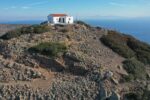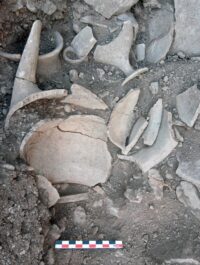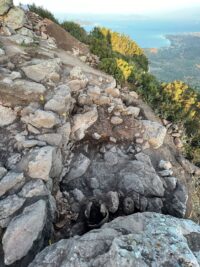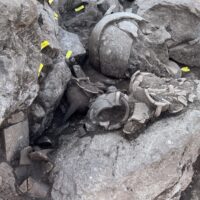 Excavations on the top of Mount Hellani, the tallest mountain on the Greek island of Aegina, have uncovered a Mycenaean building filled with vessels dating to the Mycenaean late palatial and post-palatial eras. This was the period of the Bronze Age collapse (1200-1050 B.C.), when the central administrations of the palace society disintegrated under pressure from environmental catastrophes, migrating populations and economic decline. Powerful states and urban centers were destroyed and survivors shifted to small villages. Mycenaean populations fled mainland Greece seeking refuge on Aegean islands, including Aegina, one of the islands in the Saronic Gulf less than 20 miles from Athens.
Excavations on the top of Mount Hellani, the tallest mountain on the Greek island of Aegina, have uncovered a Mycenaean building filled with vessels dating to the Mycenaean late palatial and post-palatial eras. This was the period of the Bronze Age collapse (1200-1050 B.C.), when the central administrations of the palace society disintegrated under pressure from environmental catastrophes, migrating populations and economic decline. Powerful states and urban centers were destroyed and survivors shifted to small villages. Mycenaean populations fled mainland Greece seeking refuge on Aegean islands, including Aegina, one of the islands in the Saronic Gulf less than 20 miles from Athens.

 The building is approximately 15 by 10 feet with three stone walls and a large boulder as the fourth. Inside the structure were 30 vessels of different types, including cooking pots, storage vessels and drinking goblets. When the walls collapsed, the pottery was covered by the stones from the walls, and while the artifacts were damaged, the collapsed walls protected then from complete fragmentation and scattering. The style of the pottery dates them the period of the destruction of the Mycenaean palaces and right afterwards, a time of upheaval and constant danger that drove people to seek the shelter of the highest possible ground, in this case the peak of Mount Hellani.
The building is approximately 15 by 10 feet with three stone walls and a large boulder as the fourth. Inside the structure were 30 vessels of different types, including cooking pots, storage vessels and drinking goblets. When the walls collapsed, the pottery was covered by the stones from the walls, and while the artifacts were damaged, the collapsed walls protected then from complete fragmentation and scattering. The style of the pottery dates them the period of the destruction of the Mycenaean palaces and right afterwards, a time of upheaval and constant danger that drove people to seek the shelter of the highest possible ground, in this case the peak of Mount Hellani.
 The mountain was already known as a place of worship by that time, as Aegina had been an important center of commerce and maritime trade in the Middle Bronze Age (the first half of the 2nd millennium B.C.), and a fortified enclosure on the mountaintop indicates it was used for shelter going back 4,000 years. In the 4th century B.C. a temple of Zeus was built on the northern mountain slope, and the remains of thousands of burned animal bones attest to the site’s use for sacrifices. Ceramics going as far back as the Geometric period (900-700 B.C.) have been found at the temple site.
The mountain was already known as a place of worship by that time, as Aegina had been an important center of commerce and maritime trade in the Middle Bronze Age (the first half of the 2nd millennium B.C.), and a fortified enclosure on the mountaintop indicates it was used for shelter going back 4,000 years. In the 4th century B.C. a temple of Zeus was built on the northern mountain slope, and the remains of thousands of burned animal bones attest to the site’s use for sacrifices. Ceramics going as far back as the Geometric period (900-700 B.C.) have been found at the temple site.
* This article was originally published here








No comments:
Post a Comment